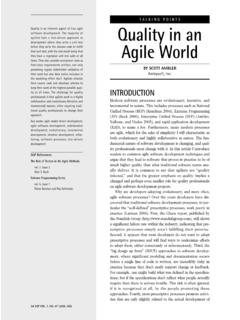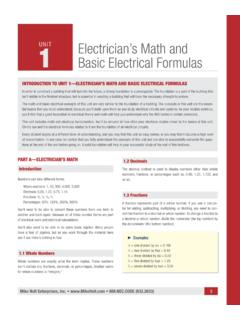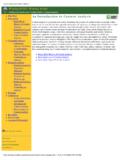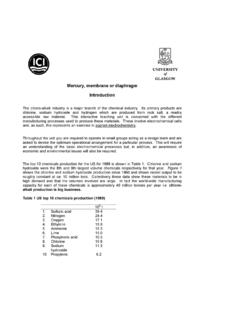Transcription of Introduction to Process Patterns - Ambysoft.com Home Page
1 An Introduction toProcess PatternsAn AmbySoft Inc. White PaperScott W. AmblerObject-Oriented ConsultantAmbySoft for this paper has be excerpted from: Process Patterns : Building Large-Scale Systems UsingObject TechnologyScott W. AmblerSIGS Books/Cambridge University Press, July 1998andMore Process Patterns : Delivering Large-Scale SystemsUsing Object TechnologyScott W. AmblerSIGS Books/Cambridge University Press, September 1998 This Version: June 27, 1998 Copyright 1998 Scott W. AmblerCopyright 1998 Scott W. AmblerVisit for more White Papers on Object-Oriented Development2 Table Of Contents1. WHAT IS A Process PATTERN?..12. TYPES OF Process TASK Process PATTERN TECHNICAL INITIAL RESULTING STAGE Process PATTERN INITIAL CONTEXT/ENTRY RESULTING CONTEXT/EXIT PHASE Process INITIAL CONTEXT/ENTRY RESULTING CONTEXT/EXIT WHY Process Patterns ?
2 107. Process REFERENCES AND RECOMMENDED ABOUT THE CHANGE HISTORY OF THIS 1998 Scott W. AmblerVisit for more White Papers on Object-Oriented Development1 Not only do the same type of problems occur across domains, problems whose solutions are addressed bydesign Patterns and analysis Patterns , but the strategies that software professionals employ to solveproblems recur across organizations, strategies that can be described by Process Patterns . A processpattern describes a collection of general techniques, actions, and/or tasks for developing object-orientedsoftware. Process Patterns are the reusable building blocks from which your organization will develop atailored software Process that meets its exact What is a Process Pattern?To define what a Process pattern is, I would first like to explore its two rootwords: Process and pattern.
3 A Process is defined as a series of actions inwhich one or more inputs are used to produce one or more outputs. Defininga pattern is a little more difficult. Alexander (1979) hints at the definition ofa pattern by pointing out that the same broad features keep recurring overand over again, although in their detailed appearance these broad featuresare never the same. Alexander shows that although every building is unique,each may be created by following a collection of general Patterns . In otherwords, a pattern is a general solution to a common problem or issue, onefrom which a specific solution may be repetition of patternsis quite a different thingthan the repetition ofparts. Indeed, thedifferent parts will beunique because thepatterns are the same. ChristopherAlexanderCoplien (1995), in his paper A Generative Development- Process Pattern Language, hints at thedefinition for the term Process pattern in his statement that the Patterns of activity within anorganization (and hence within its project) are called a Process .
4 For the purposes of this paper, I define aprocess pattern to be a collection of general techniques, actions, and/or tasks (activities) for developingobject-oriented software. An important feature of a Process pattern is that it describes what you should dobut not the exact details of how you should do something. When applied together in an organizedmanner, Process Patterns can be used to construct software Process for your organization. Because processpatterns do not specify how to perform a given task, they can be used reusable building blocks from whichyou may tailor a software Process that meets the specific needs of your to Process Patterns are something called organizational Patterns , Patterns that describe commonmanagement techniques or organizational structures. The fact is that Process Patterns and organizationalpatterns go hand-in-hand, although the focus of this white paper, however, is not organizational 1998 Scott W.
5 AmblerVisit for more White Papers on Object-Oriented Development22. Types of Process PatternsOne feature which I believe is important for Process Patterns is that it be possible todevelop them for all aspects of development. The point to be made is that the scopeof a single Process pattern may range from a high-level view of how applicationsare developed to a more-detailed view of a specific portion of the software can existat all scales. ChristopherAlexanderI believe that there are three types of Process Patterns . In order of increasing scale they are:1. Task Process Patterns . This type of Process pattern depicts the detailed steps to perform a specifictask, such as the Technical Review and Reuse First Process Patterns 2. Stage Process Patterns . This type of Process pattern depicts the steps, which are often performediteratively, of a single project stage.
6 A project stage is a higher-level form of Process pattern, one thatis often composed of several task Process Patterns . A stage Process pattern is presented for eachproject stage of a software Process , such as the Program stage presented in Figure 2, of the Object-Oriented Software Process (OOSP) of Figure 4. 3. Phase Process Patterns . This type of Process pattern depicts the interactions between the stageprocess Patterns for a single project phase, such as the Initiate and Delivery phases. A phase processpattern, the Construct pattern is depicted in Figure 3, is a collection of two or more stage processpatterns. Project phases are performed in a serial manner, this is true of both structured developmentand of object development. A common myth within the object industry is that object-oriented (OO)development is iterative in nature.
7 Although this may be true of the small, pilot projects prevalent inthe early 1990s, it is not true of today s large-scale, mission-critical applications. The reality is thatOO development is serial in the large, iterative in the small, delivering incremental releases over time(Ambler, 1998b). Phase Process Patterns are performed in serial order, made up of stage processpatterns which are performed date, the vast majority of the work in Process Patterns has been in what I would consider task processpatterns, and very little work in phase and stage Process Patterns (although you could easily argue thatsome organizational Patterns encroach on this territory). In the three following sections I will provide anexample each of a task Process pattern, a stage Process pattern, and a phase Process pattern, all taken fromthe OOSP Process pattern language (Ambler, 1998b; Ambler 1998c).
8 In Section 6 I present the Object-Oriented Software Process (OOSP), a life cycle composed of phase and stage Process Patterns , which inturn are enhanced by task Process Patterns . My experience is that when you look at Process Patterns fromthe point of view of defining/tailoring a software Process for an organization then you need the three typesof Process Patterns described in this section to be effective. I believe that task Process Patterns are a keycomponent of a software Process , but that phase and stage Process Patterns are needed to organize themand to put them into a meaningful context for your 1998 Scott W. AmblerVisit for more White Papers on Object-Oriented Development33. Task Process Pattern Technical ReviewThe deliverables created during development need to be validated to ensure that they meet the needs ofyour user community and the quality standards of your organization.
9 The Technical Review task processpattern describes how to organize, conduct, and follow through on the review of one or more pattern is of the same theme as the Validation by Teams (Harrison, 1996), Review (Coplien, 1995),Creator-Reviewer (Weir, 1998), and Group Validation (Coplien, 1995) task Process ForcesThere are several applicable forces motivating the Technical Review Process pattern. First, thedeliverables (models, prototypes, documents, source code, ..) produced during the development processhelp to define the software and related products to be released to your user community, therefore youshould validate that each deliverable is of sufficient quality before building on it. Second, because the costof fixing defects increases the later they are detected in the development life cycle (Ambler, 1998a) as aresult of the error snowballing throughout your work, you want to detect defects as early as possible so youmay fix them early (and inexpensively).
10 Third, because it is difficult to review your own work you want a second set of eyes to review a deliverable. Fourth, you want to communicate your work to others, andone way to do that is to have your teammates review the deliverables that you Initial ContextThere are one or more deliverables to be reviewed, the deliverables are ready to be reviewed, and thedevelopment team is ready to have the deliverables SolutionFigure 1 shows that there are six basic steps to the Technical Review Process pattern (model reviews,document reviews, prototype reviews, requirement reviews, and code inspections are all specific processesthat follow the Technical Review Process pattern). The steps of a technical review are as development team prepares for review. The item(s) that are to be reviewed are gathered,organized appropriately, and packaged so that they may be presented to the development team indicates that they are ready for review.









